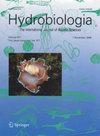Spatial and temporal organization of aquatic insect assemblages in two subtropical river drainages
IF 0.3
4区 生物学
Q4 MARINE & FRESHWATER BIOLOGY
引用次数: 0
Abstract
Background. The spatial and temporal changes of assemblages of aquatic insect can be used to detect the anthropic impacts that influence the biological communities. Goals. We compared the assemblages of aquatic insect in 1997 and 2014 in two subtropical river drainages, the association with water characteristics, and we discuss their implications for ecosystems conservation. Methods . True diversity of the aquatic insect fauna at family level and their community structure for 27 study sites in 1997 and 2014 were assessed. Multivariate analyzes were used to compare aquatic insect assemblages and the abundance of functional feeding groups. Results . There were significant differences in the dissolved oxygen (DO) of the water between 1997 and 2014, decreasing its values. Other variables correlated to DO were also modified, with a decrease in pH and an increase in temperature. We found a correlation between reduction of DO and water pH with a decline in the overall abundance of aquatic insects; also, with shifts in the community structure, from the decrease of groups such as some Ephemeroptera and scrapers, to the increase in opportunistic families such as Chironomidae, Culicidae, and other predator families such as Coenagrionidae, Corixidae and Veliidae, and more abundance of collectors. Families such as Heptageniidae and Caenidae decreased in abundance, as well as other benthic groups. Conclusions . The assemblages of aquatic insect are useful to indicate a generalized degradation of environmental conditions across localities and time in two subtropical river drainages, related to water quality degradation symptoms such as reduction of pH levels and dissolved oxygen, usually associated with anthropogenic stressors.两个亚热带河流流域水生昆虫群落的时空组织
背景水生昆虫群落的时空变化可以用来检测影响生物群落的人为影响。目标。我们比较了1997年和2014年两个亚热带河流流域水生昆虫的组合及其与水特征的关系,并讨论了它们对生态系统保护的影响。方法。对1997年和2014年27个研究地点水生昆虫区系的真实多样性及其群落结构进行了评估。多变量分析用于比较水生昆虫组合和功能性进食群的丰度。后果1997年至2014年间,水中溶解氧(DO)存在显著差异,其值有所下降。与DO相关的其他变量也被修改,pH值降低,温度升高。我们发现DO和水pH值的降低与水生昆虫总体丰度的下降之间存在相关性;此外,随着群落结构的变化,从一些Ephemeroptera和scrapers等类群的减少,到摇蚊科、库蚊科等机会主义科和Coenagrionidae、Corixidae和Veliidae等其他捕食者科的增加,以及更多的收集者。Heptageniidae和Caenidae等科的数量减少,其他底栖生物群的数量也减少。结论。水生昆虫的组合有助于表明两个亚热带河流流域不同地点和时间的环境条件普遍退化,这与水质退化症状有关,如pH值和溶解氧降低,通常与人为压力源有关。
本文章由计算机程序翻译,如有差异,请以英文原文为准。
求助全文
约1分钟内获得全文
求助全文
来源期刊

Hidrobiologica
生物-海洋与淡水生物学
CiteScore
0.40
自引率
0.00%
发文量
8
审稿时长
>12 weeks
期刊介绍:
HIDROBIOLÓGICA es una publicación cuatrimestral que difunde trabajos originales e inéditos de investigación o revisión, sobre temas relacionados con los organismos y la hidrología de los ambientes acuáticos, dulces y marinos y va dirigida a investigadores de todo el mundo, interesados en las diversas disciplinas que incluye la Hidrobiología , así como a alumnos de posgrados y licenciaturas relacionados con la biología, ecología, taxonomía, filogenia y evolución de organismos acuáticos, e hidrología y oceanografía de ambientes s dulceacuícolas y marinos.
 求助内容:
求助内容: 应助结果提醒方式:
应助结果提醒方式:


